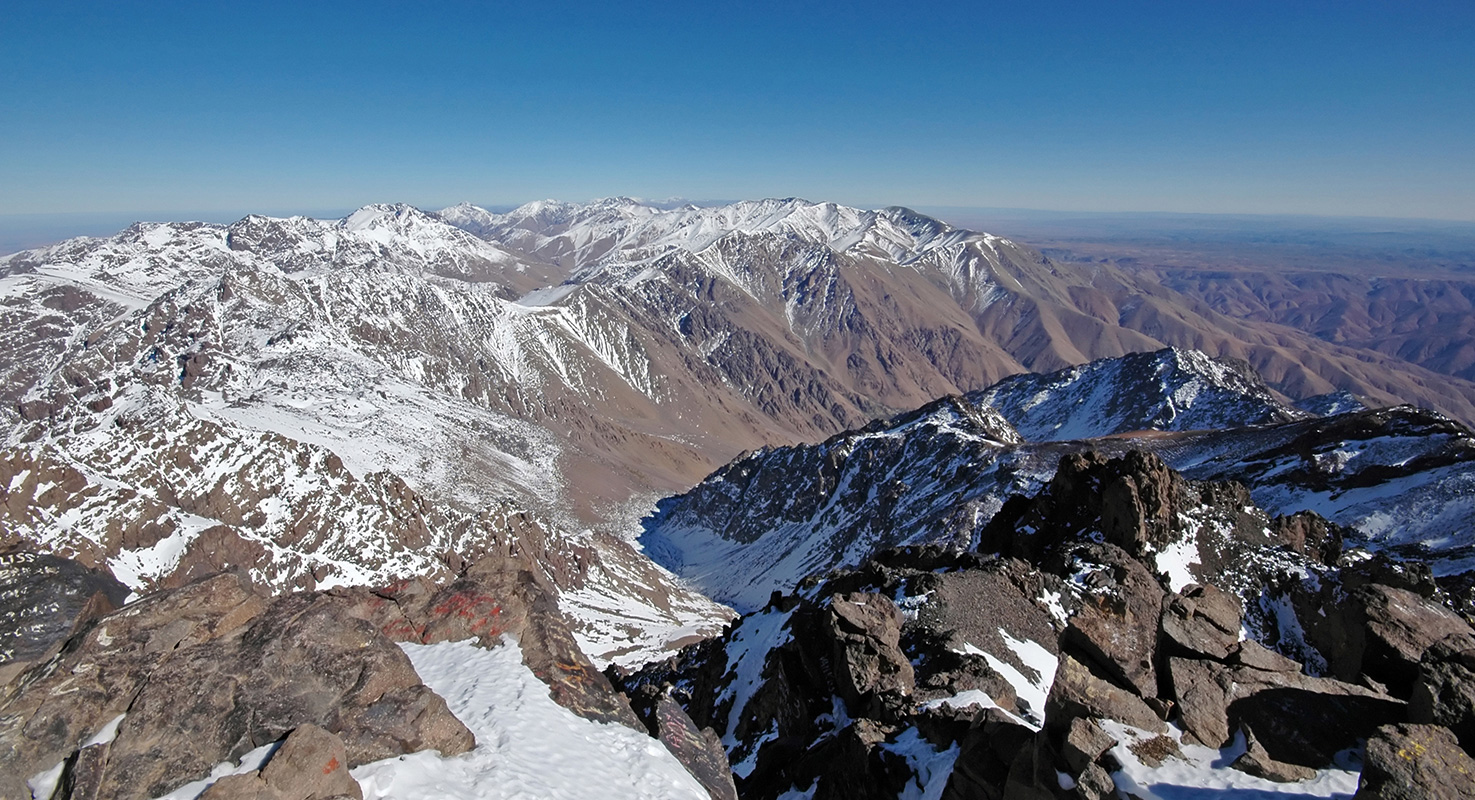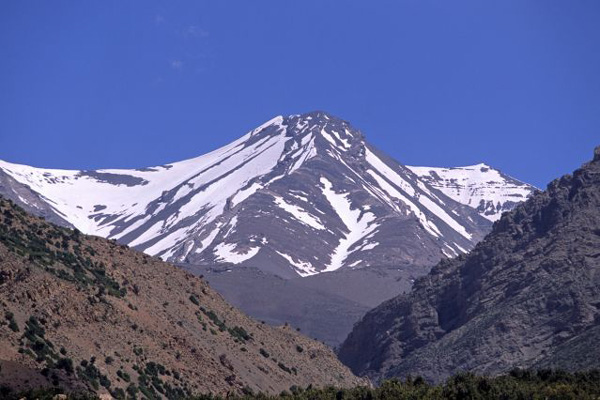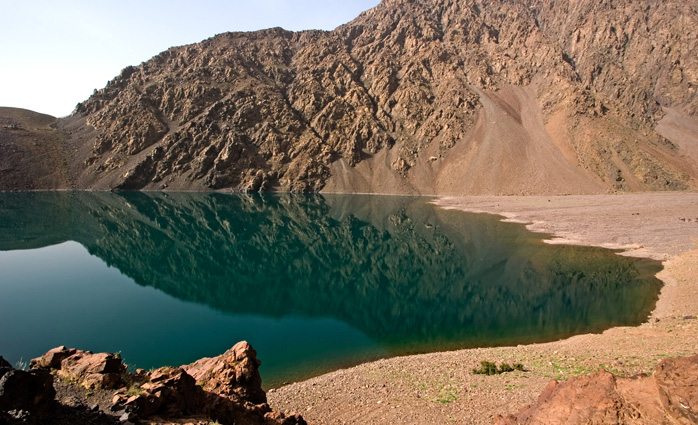THE ATLAS MOUNTAINS OF MOROCCO
Completing a splendid circuit trek of Mount Toubkal (4167m) and including the opportunity to climb to its summit, this Moroccan walking holiday provides the best of the Atlas Mountains within just a week and a half. Offering varied and picturesque scenery, rugged trekking trails, lofty peaks and passes, along with the guarantee of a cheerful welcome from the Berber people, the Atlas Mountains of Morocco are the perfect choice for dedicated hikers and trekkers. Our trek takes us across the central spine of the Atlas Mountains, by way of several pretty Berber villages and the cobalt-blue Lake Ifni, to the Neltner Refuge below Toubkal. From here, a straightforward trail leads to the highest point in North Africa, Mount Toubkal, which commands far-reaching views across the Atlas and southwards to the Jebel Sahro ranges and the distant Sahara Desert. This spectacular short trekking holiday, which includes 2 nights in the vibrant city of Marrakech, gives a real taste of Morocco.
A GENUINE SMALL GROUP ADVENTURE – THE SECRET OF OUR SUCCESS ON TOUBKAL AND IN MOROCCO.
We are proud to say that our holidays in Morocco are limited to a maximum group size of 12, ensuring we leave only our footprints on the trails whilst enjoying a genuine small group adventure. We’ve been taking our clients walking, trekking and mountaineering for almost fifteen years so we know the ingredients of a good guide and a successful group adventure. On our Toubkal treks, the mountain is neither particularly high nor technically demanding, but the experience and knowledge of our Moroccan leaders, teamed with a smaller group size, can make a big difference to your chances of success on summit day. Those who are new to High Atlas trekking will take particular comfort in the presence of our experienced Moroccan guides, who we believe are the best in the business. Our Mount Toubkal Circuit remains a great option for anyone looking for a slightly longer trekking trip.
Is this holiday for you?
The maximum altitude attained on this trek is not great and we spend only one night at just above 3000 metres. This means that altitude acclimatisation is not usually a problem. However this trek does involve some days with a good deal of ascent and descent and one or two of the days (although broken with leisurely lunches in the shade) are quite long. Additionally, the summer months in the High Atlas can be hot and July and August particularly so. This does have an effect on trekking performance. For most of the trek we follow well established trails between valleys and villages which are suitable for mules and very straightforward for trekkers. On the ascent of Toubkal and whilst trekking up to the passes on our route, we will encounter zig-zag trails on scree. Because this is a short trip we have only given grade 5.
Highlights
- Ascent of North Africa`s highest peak – Mount Toubkal (4167m)
- Explore beautiful Lake Ifni and cross four magnificent passes
- Traditional villages, welcoming Berber and friendly local trek crew
- Guided tour of Marrakech, the spectacular Djemaa-el-Fna and souks
-
Included
5 Star AccommodationAirport TransferBreakfastProfessional Personal Guide -
Not Included
Gallery TicketLunchPick up & Drop off at your Marrakech accommodation
Tour Plan
Day 1
Meet at the group hotel in Marrakech. Transfers from Marrakech Airport are provided. On arrival in Marrakech you will be met by a KE representative who will assist with the short transfer to the group hotel in the city. Depending on your flight arrival time, after settling in you may have the opportunity to do a little exploration. Marrakech is a friendly city and quite easy to get around and most people head for the central square of the Djemaa-el-Fna beneath the imposing tower of the Koutoubia Mosque. KE Land Only services begin with the evening meal. Morning sightseeing in Marrakech. Afternoon transfer to the Atlas Mountains and Ait Souka. On our first morning in Morocco, we will have a leisurely breakfast at our hotel and then visit the Djemaa-el-Fna. Even in the morning there’s a real bustle here as people go about their daily business and orange juice stalls and colourfully-painted horse-drawn open carriages vie for business. To escape the heat we’ll walk into the adjacent souk area. The shaded passages, streets and hidden squares of the souks cover a huge area on the north side of the Djemaa-el-Fna and we will be able to explore some of the most interesting and accessible parts. Pottery, carpets and leather goods are amongst the most interesting souvenir options. Hard bargaining is the name of the game when looking to make a purchase. After lunch, we will set off on the short drive to the start point of our trek. We drive southwards out of the city, with the peaks of the Atlas ahead of us. At the bazaar town of Asni, we turn away from the main road and begin to climb into the foothills of the Atlas. Our route follows the picturesque Mizan Valley and we begin to see the clustered houses of the mud-brick villages of the Berbers. In 1995, this valley (along with the Ourika Valley to the north-east) was devastated by a flash flood and the villages, agriculture and the road itself are only gradually recovering from this event. Imlil is effectively the end of the road from here we can either walk along the jeep road to the village of Ait Souka or continue in the vehicle. The area around Imlil was used in 1997 as the backdrop for parts of the major Hollywood movie “Kundun”. The old kasbah above the village was renovated and made to look like a Tibetan temple. We check in to an excellent gite at Ait Souka and can take tea on the roof terrace, with great views of a range of peaks including Toubkal itself.
Day 2
Acclimatisation day in and around the charming Aroumd Valley. Today is a day for acclimatisation in and around the charming Aroumd Valley. To help with this process, we’ll take a short day walk above the village. One option is to take an easy-paced stroll back towards Ilmil before heading up a side valley to reach a col at 2660m. The walk up the Mezzik Valley gives a good introduction to the type of terrain and trails we’ll be covering on our trek. The path is stony but clearly defined and winds its way up above cultivated terraces and walnut trees to reach a col – or tizi as they are known locally. We’ll take a leisurely lunch in the shade, allowing those with sufficient energy the chance to climb on to reach a viewpoint above the col. We retrace our steps to return to the gite, with an excellent view across to our route of the following day.
Day 3
Trek to the cultivated areas of Ouanesekra via the Tizi-n-Tamatert Pass (2279m). Beginning our trek, we follow a trail towards the village of Tamatert. Beyond this traditional Berber settlement, a jeep road hairpins up to the Tizi-n-Tamatert (2279m) Our path cuts through the most radical of these zig-zags, leading to the pass in a total of around 2 hours. After pausing for refreshment we then follow a traversing track with good views across the Imenane Valley to the impressive Jebel Oukaimeden (3273m). To find a suitable camping place, we will need to walk up above the cultivated areas of Ouanesekra. Across the valley we can see the village of Tacheddirt, another popular base for trekking in the High Atlas where there is a Club Alpin Francais (CAF) sponsored lodge in the village.
Day 4
Trek up the Tizi-n-Likemt (3550m) and through a colourful landscape to Azib Likemt (2550m). A harder day today as we start the climb to the Tizi-n-Likemt (3550m). The views improve as we gain height, passing through a landscape of multi coloured hillsides and rocky peaks, with the greenery of the valley below us. It is a 4-hour climb to the pass where we put on a couple of layers of clothes and may stop to eat a picnic lunch. Around 1000m of descent on the south side of the range takes us to the grazing area of Azib Likemt (2550m) where we camp alongside a stream. This provides the chance to cool our feet and to take a refreshing wash. There are some rudimentary huts on the Azib Likemt which are occupied in the summer months by Berber herdsmen from the lower villages. This is an unusual and quite complicated highland area, with high valleys separated by mountain ridges rising to 3500m or more.
Day 5
Trek alongside the Assif Tinzart stream to Tizi-n-Ourai (3109m) and the edge of the Agaz Ran valley. From camp we head north for a while until we can turn south to follow the stream known as the Assif Tinzart. Initially, this is a narrow and quite rocky valley, with the stream passing through a series of pools and gorges. As the valley opens out we reach a high meadow, beneath the windy col of Tizi-n-Ourai (3109m). From the col, far below us, we can see the green valley of the Assif Tizgui and beyond this, to the west, is the massive summit of Toubkal. Dropping down steadily, we pass through several small villages and finally arrive at the valley floor. The location of our campsite tonight will depend upon the season. If the terraces above the village of Amsouzart are free of crops we’ll camp here. Alternatively we’ll camp further up the valley on the edge of Agaz Ran.
Day 6
Spectacular trekking day towards the beautiful Lac Ifni, the largest lake in the Central Atlas. this valley and plenty of opportunities to stop off for tea or coca-cola at wayside tea-stalls and lodges. A popular spot is the Café Toubkal, with tables set beneath the shade of a large walnut tree. We reach the lake after a long series of zig-zags and then take a path which traverses high above the north side of the lake to reach its western end. We arrive in time for lunch and will have time to relax by the biggest lake in the central part of the Atlas, or go for a swim to cool off. Tonight we’ll either camp near the lake shore or, water supply permitting, a further 45 minutes to an hour’s climb from the lake, thus slightly reducing our ascent the following day.
Day 7
Trek over the superb Tizi-n-Ouanoums Pass (3650m) and ascend to the Neltner Refuge, Toubkal Basecamp Above the lake, we follow the upper valley of the Assif a Moursaine, heading ever upwards to one of the most spectacular pass crossings in the Atlas. The Tizi-n-Ouanoums is at an altitude of 3650m and it is a long climb of 4 to 5 hours to reach this rocky col, situated between the two highest peaks in the Atlas: Toubkal and Ouanoukrim. Turning towards the north, we now drop down steeply on scree into the upper part of the valley of the Mizan River. At the first level area, due west of Toubkal, we arrive at the Neltner Refuge. This mountain hut was constructed by the Club Alpin Francais in 2000 and has been designed to resemble a Berber fortified dwelling. We camp on one of the level sites near the hut.
Day 8
Exciting ascent of Mount Toubkal (4167m) before descending to Ait Souka via Sidi Chamharouch. A long day for those who choose to make an ascent of Jebel Toubkal (4167m) North Africa’s highest peak. After an early breakfast, we set off on the steep ascent. Our route zig-zags eastwards, directly above the hut across scree and boulders, before passing between two rocky guardian peaks to reach a high corrie which usually holds patches of old snow. We continue upwards across more scree, with the views becoming more expansive as we reach the ridge-line which drops off steeply to the east. After a total of 3 to 4 hours, we arrive at the metal tripod which marks Toubkal’s summit. There are breathtaking views of the peaks of the High Atlas away to the north-east and of the Anti Atlas and the Sahara to the south. Descending to the hut in 2 hours, we have lunch before making the long hot walk back down to our overnight accommodation in Ait Souka. On this descent, below the Neltner Refuge, we pass through the unusual hamlet of Sidi Chamharouch which is tucked under the steep mountainside, where a stream emerges from a rocky gorge. A huge white-painted boulder marks the spot where, legend has it, Saint Chamharouch lies entombed. Along the route today there are several wayside stalls where it’s possible to buy a cup of Berber tea or a cool drink. The descent to the gite in Ait Souka takes a total of 7 to 8 hours walking.
Day 9
Transfer to Marrakech. Free time to explore Marrakech before visiting Djemaa-el-Fna in the evening. Today we make the short walk down to Imlil, where we meet our transport for the drive back to Marrakech. Arriving before lunchtime we check in to the group hotel and have the rest of the day free for sightseeing. In the early evening we will certainly want to check out the remarkable central square of the Djemaa-el-Fna. At around 4 pm each evening this large open square becomes the focus of activities for local people and tourists alike. Troupes of Berber acrobats and musicians, together with snake-charmers, water sellers and story tellers begin their evening performances which become more and more animated as the sun sets. We could take a snack from one of the dozens of amazing food stalls which spring up as if by magic in the centre of the square, illuminated by hurricane lamps and offering all manner of mouth-watering delicacies.
Day 10
Departure Day. Transfers to Marrakech Airport are provided. KE Land Only services end after breakfast. There is a complimentary transfer to the airport to check-in for our return flight.
Reviews Scores and Score Breakdown
Aliquam lorem ante, dapibus in, viverra quis, feugiat a, tellus. Phasellus viverra nulla ut metus varius laoreet. Quisque rutrum. Aenean imperdiet. Etiam ultricies nisi vel augue. Curabitur ullamcorper ultricies














